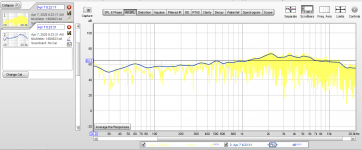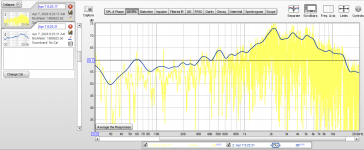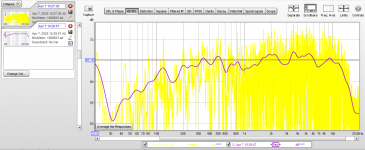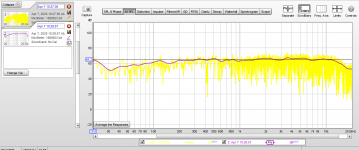Sorry to hear about your negative feelings Steve and I think I can understand. I have not walked the road you walked, but the reason I am interested and value your observations is there are relatively few EPS builds mentioned here and on the other threads, yet it does appear that EPS performs better than the goto XPS panels. Was your username lordtarquin on the NXT Rubbish thread perhaps?
Twocents.
Zigadr was the main pushing force for very large vh eps panels ,you wouldn't no it so much because he deleted himself after an argument with someone , practically all of his work lost!!!
Sedge (not very imaginative) was me.i mainly used 1inch 70 grade eps from my local DIY store , only because it was cheaper and the only way at the time to get large (8ftx4ft ) panels,I only managed to get small (40cmx40cm x5mil and 10mil) samples of vh grade ,so a like for like comparison wasn't done.
I became sidetracked when people kept saying small panels were no good,so decided to find out,it has been very interesting and have learned a lot, it's so much easier and quicker to build small panels and change them about.
Several large panels in my room would be a nightmare.
I thought I could make a 4inch panel to use as a tweeter ,but I don't know any tweeters that go down to about 400hz ,which put it in the range of my normal roll-off of my LF speakers.
So I can swap between large and small panels with the same xo.
I see no reason why you can't have the dml sound in a small room ,and am now of the opinion that small rooms probably should have small panels and large rooms large panels.
Similar to what size TV you would have in a small or large room.
The various materials I have used are not as efficient as eps but they still play loud enough in my room with my 10watt exciters.
Sorry got a bit carried away.
Steve
Hi davelang, they sound a bit like this, plus a better soundstage, more air around the music, and a less 'phasy' quality. These recordings were done late last year. (I removed some hiss from that tracks that came from my homemade mics, it also removed a bit of presence from the tracks)
I am going to get them out and re-measure them again properly, and play with some eq'ing and a sub-woofer this time. I have already found out through some quick measurements that I can halve the blu tack that I have over the voice coil centres and maintain the smoothing it gives between 5 - 10k with less drop in responce around 300 - 500hz.
I have the same sound track of walking on the moon,and was wondering if I could use my phone to make a comparison,but what about royalties and the like? Do you upload the same as a picture?
I'm willing to give it a try.
Recordings I've made of church organs on my phone have sounded ok ,as long as you take the acoustics into account.
Even if the recording doesn't sound great,it does give an idea of what to expect
Just a thought
Steve
I have used iphone and AudioTools App, which has a nice 12 band FFT program, combined with a white noise digital track to compare between speakers. Without a anechoic chamber and precision mics and recording, it is very difficult to make absolute conclusions.
With a iPhone you can measure different speaker response curves relative to each other in your setup and your room
For example I thought I was hearing better high end extension with my plexiglas panels than with my XPS panel. I was able to confirm this with my simple iPhone setup. I can only compare in my setup.
With a iPhone you can measure different speaker response curves relative to each other in your setup and your room
For example I thought I was hearing better high end extension with my plexiglas panels than with my XPS panel. I was able to confirm this with my simple iPhone setup. I can only compare in my setup.
REW measurements with DSP equalization. Yellow is raw. Purple is smoothed using psychoacoustic filter. I tried to keep the frequency response within +/- 2.5db between 200hz to 15,000hz. I tried to kill the signal after 15,000hz for the sake of my dog.
Attachments
Last edited:
New REW measurements. No DSP equalization. Yellow is raw. Blue is smoothed using psychoacoustic option.
Very cool. Probably more precise than what I am doing. I had to shut of fridge, furnace and water pump to avoid extraneous sound artifact. How do these programs deal with background and ambient noise when doing correcting
Very cool. Probably more precise than what I am doing. I had to shut of fridge, furnace and water pump to avoid extraneous sound artifact. How do these programs deal with background and ambient noise when doing correcting
It sends the signal through the speakers so it knows what it should be hearing.
It sends the signal through the speakers so it knows what it should be hearing.
Don’t you have to mike the speakers or room? What’s to stop a ambient noise from getting into the feedback loop?
Don’t you have to mike the speakers or room? What’s to stop a ambient noise from getting into the feedback loop?
The speaker and mic are both controlled by REW.
Don’t want to beat a dead horse but say you have a 60 cycle rumble in your house and a 60 cycle signal coming from your siggen out to the speakers - how does the program know what component of that signal amplitude is from what source?
Don’t want to beat a dead horse but say you have a 60 cycle rumble in your house and a 60 cycle signal coming from your siggen out to the speakers - how does the program know what component of that signal amplitude is from what source?
I use a USB measurement mic from MiniDSP. It comes with a calibration file which REW uses in its measurements. The idea is to have your measurement signal from about 1m around 80dB which should be well above the noise floor. The low end is always difficult due to influences from the room. REW is a great tool and FREE.
Thanks, Dave
Hi Dave, When making the REW measurements the program does see the ambient noise along with the signal coming from the signal so one tries to keep it quite or should.
I have been playing around with the exciter response since the impedance is not constant across the frequency band. So one does not have equal power across the frequency band. If your amplifier is flat or constant gain and using the equation P= V^2/R one sees how the power varies across the frequency. I have been using a two prong approach where I use a DSP Power amp. ( where I model out the impedance of the exciter) and then a DSP filter to flatten out the speaker response .
This give a very good audio response . I have all my friends who are in various local jazz groups over (before Covid-19 lock down) and they all are all so impressed. They can not believe the sound that the system produces it is a transcendental experience the closest to having the musicians there.....
Cheers
Steve
I have been playing around with the exciter response since the impedance is not constant across the frequency band. So one does not have equal power across the frequency band. If your amplifier is flat or constant gain and using the equation P= V^2/R one sees how the power varies across the frequency. I have been using a two prong approach where I use a DSP Power amp. ( where I model out the impedance of the exciter) and then a DSP filter to flatten out the speaker response .
This give a very good audio response . I have all my friends who are in various local jazz groups over (before Covid-19 lock down) and they all are all so impressed. They can not believe the sound that the system produces it is a transcendental experience the closest to having the musicians there.....
Cheers
Steve
Thank you bradleypnw, intaud, and tagis!
I think I get it. The system records ambient noise as part of its calibration file and then somehow subtracts it from the sound from a calibrated sound file and then outputs to the speakers a corrected signal to flatten and smooth the final sound output.
I just downloaded the software... I need to stop blathering... Thanks for helping me understand. Truly appreciated.
I think I get it. The system records ambient noise as part of its calibration file and then somehow subtracts it from the sound from a calibrated sound file and then outputs to the speakers a corrected signal to flatten and smooth the final sound output.
I just downloaded the software... I need to stop blathering... Thanks for helping me understand. Truly appreciated.
It is best to try and have your background noise as low as possible when testing, as REW hears everything during the measurment, and includes it. I don't think REW takes into account/subtracts other noises and room reflections happening in your room at the time, it just records them all along with your speakers' output. This is why anechoic chambers are best for testing, and probably why JBL(?) used to test their systems outside and 40 feet in the air, on a quiet day I presume. REW is a very complete system, with lots to learn. Have fun!
Last edited:
It is best to try and have your background noise as low as possible when testing, as REW hears everything during the measurment, and includes it. I don't think REW takes into account/subtracts other noises and room reflections happening in your room at the time, it just records them all along with your speakers' output. This is why anechoic chambers are best for testing, and probably why JBL(?) used to test their systems outside and 40 feet in the air, on a quiet day I presume. REW is a very complete system, with lots to learn. Have fun!
On HolmImpulse you can select a "noise" graph. I have assumed that that response is anything that was not part of the original test signal, that it was either ambient or created by the speaker. The noise usually is near the level of the harmonic distortion graph.
In my case I: sweep then equalize, sweep then equalize, sweep then equalize, ad infinitum. If any background noise showed up in one sweep it would be gone in the next.
In my case I: sweep then equalize, sweep then equalize, sweep then equalize, ad infinitum. If any background noise showed up in one sweep it would be gone in the next.
Hi bradleypnw. Are you using REW for the above? I'm not (that) familiar with HolmeImpulse if you're using that, as 'dbjohns' mentioned. I tend to use REW for measurements, DRCDesigner to play with DSP/DRC, and then playback through JRver to test measurements and implement any DSP/DRC. Not saying these are the best software to use, just don't cost that much (some free) and work well for me.
I have started to look into room diffusers and bass traps, but these really have a low WAF. 🙁 But in the end, would probably, in terms of performance increase be worth the grief.
I have the same sound track of walking on the moon,and was wondering if I could use my phone to make a comparison,but what about royalties and the like? Do you upload the same as a picture?
I'm willing to give it a try.
Recordings I've made of church organs on my phone have sounded ok ,as long as you take the acoustics into account.
Even if the recording doesn't sound great,it does give an idea of what to expect
Just a thought
Steve
Hi Steve. For these files I recorded the audio into my laptop and exported from a video editing program as mp4's with no picture. There are, I'm sure, other ways to create audio only mp4's. mp4 seems to be the only uploadable format allowed on this forum for A/V files, other than zipping other formats, but then only to 3.18meg in size.
My way of looking at it is who would want my DML recordings in their music collection, and a lot of the music I have purchased and now listen to is due to exposure from this site and others like it.
- Home
- Loudspeakers
- Full Range
- A Study of DMLs as a Full Range Speaker



